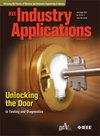Enhanced Ventilation and Thermal Performance by Inclined Through Holes on Rotor Yoke in Permanent Magnet Synchronous Wind Generators
IF 4.5
2区 工程技术
Q2 ENGINEERING, ELECTRICAL & ELECTRONIC
引用次数: 0
Abstract
The cooling performance of medium-speed permanent magnet synchronous wind generators (MS-PMSWGs) is critically important, as it determines the sustained output power and reliability. This paper proposes a novel rotor structure featuring inclined through holes, which based on forced air-cooling method. On the one hand, the through holes provide additional flow paths for cooling air, effectively reducing flow resistance. On the other hand, as the rotor rotates, a pressure difference is created between the two ends of the holes, which generates the airflow independently. To accurately calculate the flow and thermal fields, three-dimensional (3-D) computational fluid dynamics (CFD) models have been established. Using the basic design of a 1.5 MW MS-PMSWG, a comparative analysis is conducted between the conventional structure and the proposed design. Under rated operational condition, the pressure required for the cooling fan to generate the same flow rate is significantly reduced by the adoption of the proposed holes, as well as the temperature rises of the windings and permanent magnets are reduced. Moreover, under the fault condition with the fan shutdown, the operational capability is greatly enhanced, attributing to the airflow generated by the rotating holes. Furthermore, reduced scale prototypes are built adhering to the principles of Reynolds similarity, and the effectiveness of the proposed structure is experimentally validated.永磁同步风力发电机转子轭上斜通孔改善通风和热性能
中速永磁同步风力发电机(MS-PMSWGs)的冷却性能至关重要,因为它决定了持续输出功率和可靠性。提出了一种基于强制风冷的斜通孔转子结构。一方面,通孔为冷却空气提供了额外的流动路径,有效地降低了流动阻力。另一方面,当转子旋转时,在孔的两端产生压力差,从而独立产生气流。为了准确地计算流场和热场,建立了三维计算流体力学(CFD)模型。以1.5 MW的MS-PMSWG的基本设计为例,对传统结构和设计方案进行了对比分析。在额定运行条件下,通过采用所提出的孔,冷却风扇产生相同流量所需的压力显著降低,并且减少了绕组和永磁体的温升。此外,在风机关闭的故障状态下,由于旋转孔产生的气流,运行能力大大增强。此外,根据雷诺相似原理建立了缩小尺寸的原型,并通过实验验证了所提出结构的有效性。
本文章由计算机程序翻译,如有差异,请以英文原文为准。
求助全文
约1分钟内获得全文
求助全文
来源期刊

IEEE Transactions on Industry Applications
工程技术-工程:电子与电气
CiteScore
9.90
自引率
9.10%
发文量
747
审稿时长
3.3 months
期刊介绍:
The scope of the IEEE Transactions on Industry Applications includes all scope items of the IEEE Industry Applications Society, that is, the advancement of the theory and practice of electrical and electronic engineering in the development, design, manufacture, and application of electrical systems, apparatus, devices, and controls to the processes and equipment of industry and commerce; the promotion of safe, reliable, and economic installations; industry leadership in energy conservation and environmental, health, and safety issues; the creation of voluntary engineering standards and recommended practices; and the professional development of its membership.
 求助内容:
求助内容: 应助结果提醒方式:
应助结果提醒方式:


